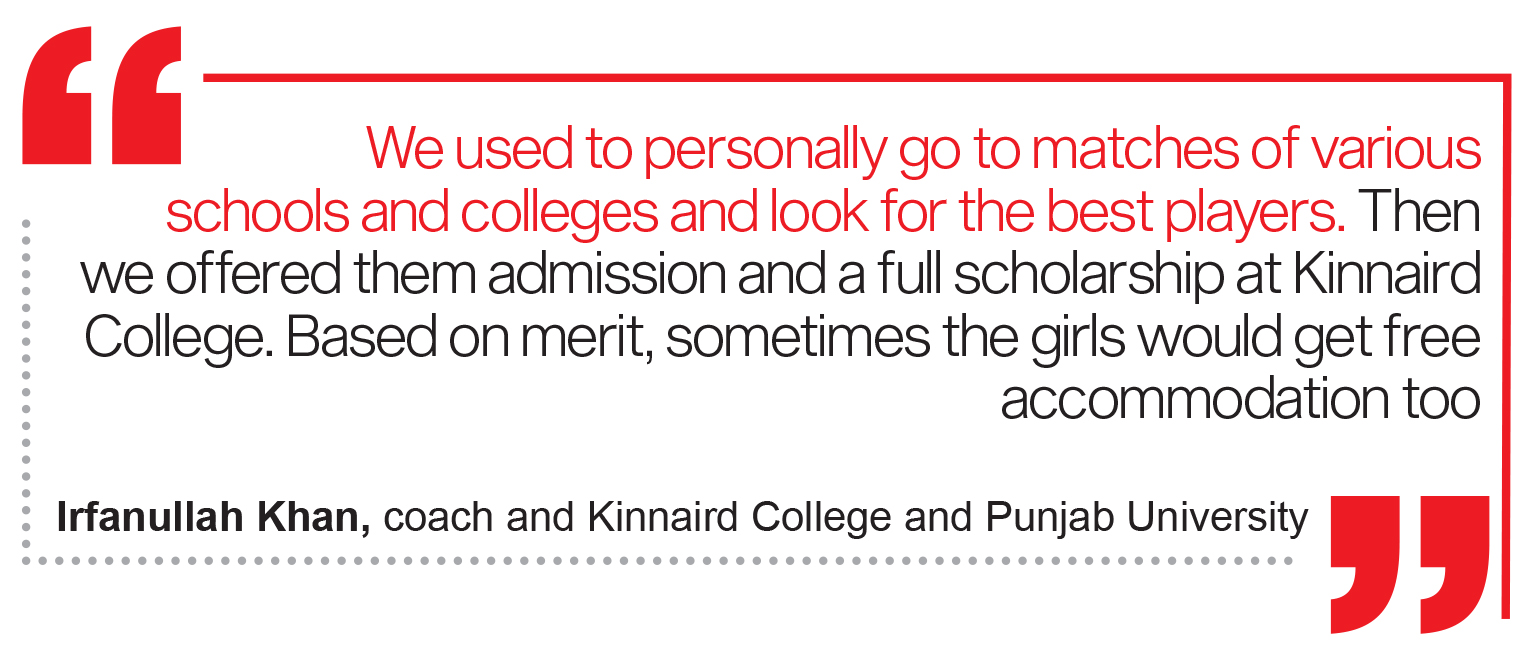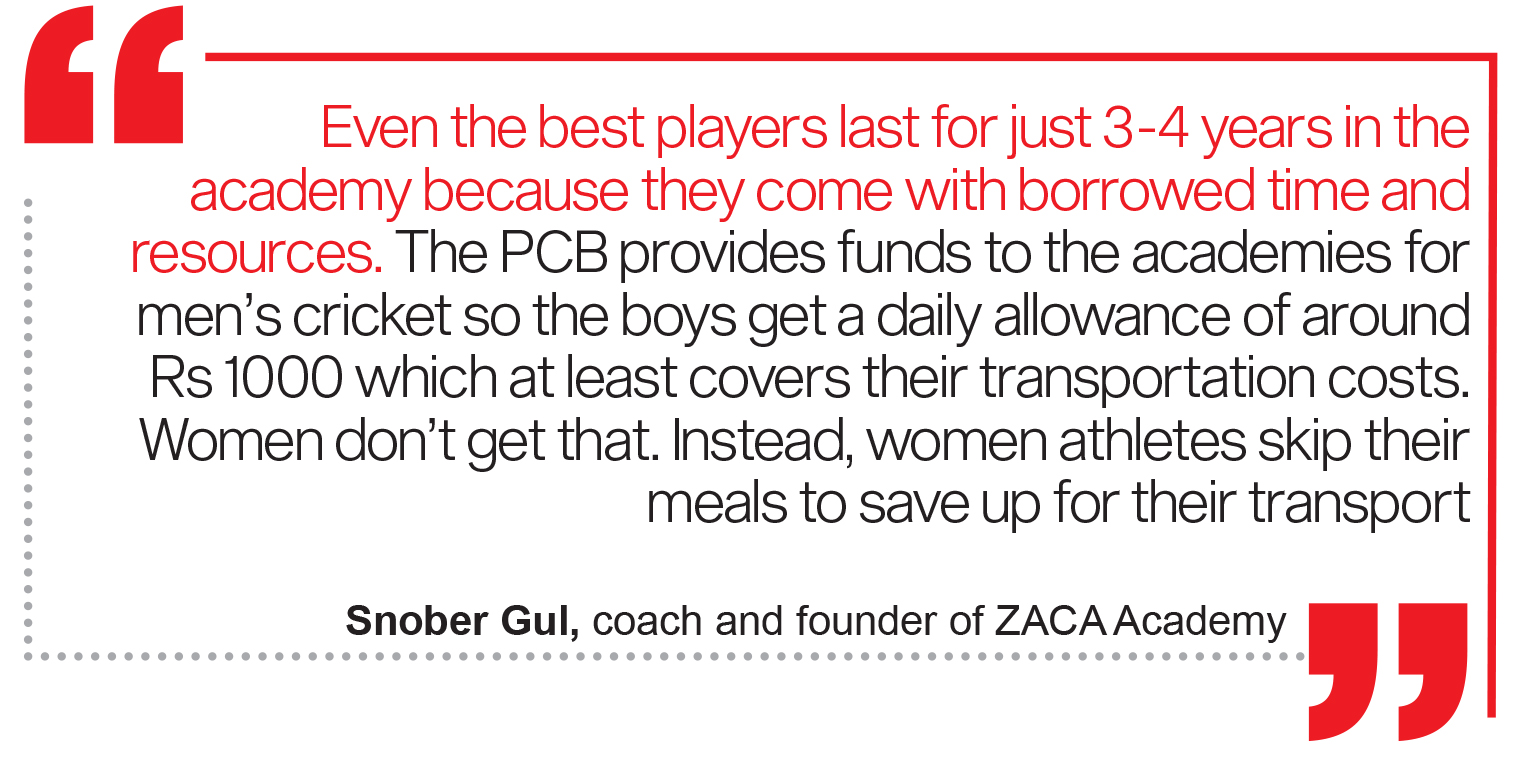In 2009, Saba Nazir from Muridke collected her meagre savings and boarded a bus for the nearby town of Sheikhupura to bowl in front of selectors from the Pakistan Cricket Board (PCB). The young, small-town girl immediately caught the eye of the headhunters and was asked to return again to play a game the next day.
That is where her struggle started.
In Pakistan, perhaps one of the biggest victories for upcoming players in women’s cricket is managing to show up for the match. Only 16 years old in 2009, Saba had to use her own savings collected over the years from Eidis and skipping school lunches to get a ticket to Sheikhupura. Her family could not have afforded to spend money on her cricket. Even if they had, they were too strict to let her play cricket within her own city let alone in Sheikhupura.
“I was scared of losing my way. And to compound that was the fear of my brothers or someone from the neighbourhood spotting me boarding a bus by myself. If anybody at my house had found out, I wouldn’t have survived,” she recalls.

Stories like this are rife in the recent book by Aayush Pruthna titled ‘Unveiling Jazba’ that chronicles the story of women’s cricket in Pakistan. In a country of 220 million where there is just one commercially successful sport, the extent to which women’s participation has been neglected is near-on criminal. On the one hand, pursuing a career in cricket is fundamentally a slippery slope for anyone. But the rules seem to be rigged for women. From street cricket to official trials, practising the sport is a nightmare for women — a fact that governing bodies don’t really account for.
Despite the odds, Pakistani women have shown a persistent passion for the game that has translated into Pakistan competing regularly on the world stage where there have been rare moments of team and individual brilliance that have captivated audiences. Yet investment in the women’s game remains low and so does interest. The question is, do we need to pump money into the sport to get audiences interested or do the audiences have to come first for the money to come in? And even if the PCB manages to attract investment, what are some of the structural issues that Pakistan’s women cricketers face?
The chicken and egg equation
This is a question that arises about most women’s sports. Whether audiences bring in investment or investment brings in the audiences. From what it looks like cricket is no different to other sports in that you have to put in the money to actually have a quality product that fans will gravitate towards.
In Pakistan, this is a two part issue. You see, the sole purpose of a body like the PCB is to promote the sport and produce the best quality players it possibly can that can compete on an international level. However, the board is an independent institution that makes its own money and needs to be profitable so that it can spend that money on player and game development. In Pakistan, the argument many experts have made is that women’s cricket is a financially viable sport but it needs to be given the requisite attention and some level of affirmative action.
“Australia’s Women’s Big Bash League (WBBL) answers this question. Around ten years ago the board launched a new product which ran alongside the ongoing Big Bash League (BBL). The investors were in losses for the first 5-6 years but the league kept on going,” says Aayush Puthran, author of Unveiling Jazba. “Even during COVID, the investment did not stop when a lot of the boards throughout the world cut their funding. And now it’s one of the most watched leagues in the world,” he says excitedly.

It’s simple, when you invest in a sport it becomes something which people want to watch and corporate wants to invest in. And the initial years are always going to run losses. Just look at the Pakistan Super League (PSL). Most of the team franchises are still running financial losses. However, franchise sports are always a long-term investment. As more and more money comes into the sport the spectacle surrounding it grows and so does the audience and its value.
“This has been something that has been very obvious for a while, you need to pump in the money,” says Osman Sammiuddin, senior editor at ESPN Cricinfo. “Just look at the recent game between Australia and India at the Newlands stadium. It wasn’t a particularly great crowd on that day but that doesn’t mean you don’t hold it at that stadium. Because at the end of the day, the quality of the contest you’re getting is pretty good and that means the crowds will come in and there will be a shot at making money too.”
This philosophy, perhaps, has also been behind the idea that was proposed last year while Ramiz Raja was chairman of the PCB that there could possibly be a women’s PSL. The PCB had announced the tournament to be played alongside the current edition of the PSL with 12 games to be played in Rawalpindi.
“This event is aligned to our strategy of making Pakistan a stronger cricket playing nation across all formats and genders. We are not only creating attractive brands to strengthen our cricket economy, but through this tournament are also providing career opportunities to our women cricketers. The more our women cricketers will participate in high-pressure events, the more they will learn,” said the former chairman Raja at the time of the announcement.
However, the project is on hold for now after Raja was ousted from the PCB and replaced by Najam Sethi who enters another stint as the top-dog at the board. In January this year, the new PCB management committee, headed by Najam Sethi, decided to shelve the league, with the aim of holding it in September. The new league – which will bear a different name – will be a standalone tournament with four teams, it was announced. This of course means that the tournament will not be able to benefit by synergising with the existing brand value that the PSL has created over the past eight years.

Meanwhile, across the border in India the BCCI also launched its new product, the Women’s IPL, in which Smriti Mandhana is auctioned for $415,000, a figure a lot more than Babar Azam’s pay in PSL. On the other hand, the PCB announced a women’s league in October 2022 to run alongside PSL, but as the time came the league was cancelled and women got just exhibition matches at the PSL as a consolation prize.
A women’s league would be essential for a number of reasons. For starters, it would prompte and bring the women’s game more to the general public and break the myth that it isn’t as watchable. The second part will be that it will uplift women cricketers that up until now face a long and difficult road towards becoming stars in Pakistan and even then do not get the same recognition as their male counterparts. And perhaps more importantly it will inject some much needed diversity into the pool of players in Pakistan’s women’s cricket. Because right now, the scene is a quagmire of conflicting interests and everyday financial burdens.
What goes behind making it to the PCB
The reality for women’s cricket is far bleaker than what is portrayed by the PCB. Starting right from home, women have to fight to play cricket or reach the ground. In a conversation with Snober Gul, coach and founder of ZACA Academy, Rawalpindi, Profit learned that a lot of women across Pakistan have the talent to play, but they simply can’t afford to. “Even the best players last for just 3-4 years in the academy because they come with borrowed time and resources. The PCB provides funds to the academies for men’s cricket so the boys get a daily allowance of around Rs 1000 which at least covers their transportation costs. Women don’t get that. Instead, women athletes skip their meals to save up for their transport,” explains Gul.
ZACA Academy was founded in 2017 with a special focus to train girls under the leadership of the Punjab government. The academy was affiliated with the PCB for a couple of years but the funding stopped when the government changed and PTI came to power. This is a common practice in the board and cricket academies, consequent government stop funding the project initiated by the previous ones. “From 2018 onwards I have had to self-finance the academy. I never took a single rupee from the girls. Coaching is not my means of livelihood. I have a business and I keep pouring money from that to my academy. But since last year the situation has become really difficult for me also and I will have to stop women’s cricket,” sighed Gul.
For coaches or for players, the monetary compensation is quite less. Gul is a PCB-trained coach and receives a salary of just Rs 50,000. His co-coach is Naila Nazir, who played in the national team from 2009-2015 and gets just Rs 35,000. “So how can one continue to dedicate to women’s cricket in such a situation?” Gul asks.

The premise of women’s cricket is the lack of development for support. Talent comes from all over the country, but the selection centres lie only in big cities like Karachi and Lahore, which automatically excludes a significant proportion. “Ideally, the PCB should run promotional campaigns for women’s cricket, sponsor local tournaments on campuses and academies, and scout for girls from colleges and regional level teams,” explains Eman Arbab, an up-and-comer with a keen eye for cricket who hosts an online show titled Double Wicket Maiden. “But it doesn’t do that. The best bet is to get into a team like Kinnaird college’s which pushes its women to national levels.”
The contribution of women’s colleges
Historically, girls’ colleges such as Kinnaird have contributed a lot in women’s cricket. The college has produced many big names including Aliya Riaz, Sadia Amin, Anum Amin, Fariha Mehmood. Profit reached out to Irfan Ullah Khan, the team coach at Kinnard and Punjab University for the last 12 years. Back in 2005-2006, Mira Phailbus, the former education minister in the caretaker government and then principal of Kinnaird College launched women’s cricket and invested with donations. Soon cricket received partial funding from the PCB as well. The college conducted inter-college matches and trials for school and college girls all across Lahore.
“We used to personally go to matches of various schools and colleges and look for the best players. Then we offered them admission and a full scholarship at Kinnaird College. Based on merit, sometimes the girls would get free accommodation too,” said Khan.
Colleges provided the perfect opportunity for rigorous practice and development of the player. “Women’s cricket is different. Women don’t have the same problems as men. At Kinnaird, we made sure that the coaches, sports physicians and the rest of the staff were women to understand their problems. It’s only in a safe and trusted environment where a woman can play freely,” said Khan.
Kinnaird college, as well as Punjab University and Lahore College for Women provides trials with the PCB, which begins the professional journey for many players. The environment, coaching and support push the women to keep playing, but the pay is still very less. “I did not receive any pay for 12 years, only enough cash to cover my conveyance,” said Khan, “But I continue to support the game because Kinnaird has become like my family, even though I have moved to Punjab University now.”
Personal contribution and its side effects
Investing in women’s cricket is more a contribution than a job. That’s why women from poorer backgrounds often don’t make it to the national team because they lack resources. In the 1990s, Shaiza Khan made enormous contributions to the game. Khan hailed from a feudal family that had to navigate internal rivalries in women’s cricket to gain legitimacy from the PCB and ICC.

Back in the day, the internal grouping of Karachi vs Lahore factions was intense and wouldn’t let the other team go forward. Khan contacted the Australian cricket coach Jodie Davis to train her team under the banner of PWCCA, arranged flights for the team for the 2007 World Cup in New Delhi, and eventually got recognition from the PCB and International Women’s Cricket Council (IWCC) as the official women’s representative.
What Shaiza did prove to be historical for Pakistan as it marked the national team’s first international appearance. But it also paved the way for factionalism, which exists in numerous forms to date.
“The likes of Urooj Mumtaz, the richer ones in cricket, have destroyed the game,” blurted Khan while talking about Kinnaird College’s cricket. “She has enough resources and connections in the PCB to build and promote her club ZTBL in Karachi, at the cost of other talented girls from Punjab.”
However, at the same time, it’s only the colleges from Lahore which have developed a clear pathway for selection which often creates contention among others. “Kinnaird has done tremendous service for women’s cricket. But now with other colleges in Lahore, it maintains a monopoly of sorts. There’s a fair argument many cricket fans have brought forward, why were players like Sidra Amin pushed over Javeria Khan’s opening spot in the T20 squad? The selection process is unclear and marred by limited recruitment channels,” said Arbab in talking about the overall development of women’s cricket.
When the authorities resign from their responsibilities, other stakeholders have to step in. This hinges on the long-term development of the game, something which is very evident in different eras of men’s cricket as well. With the exhibition matches set to take place on 8th, 10th and 12th of March, it promises to bring a larger recognition from the ordinary public which one can hope will bring some transparency in the system as well.


























Wow what a Great Information about World Day its very nice informative post. thanks for the post.
Positive site, where did u come up with the information on this posting? I’m pleased I discovered it though, ill be checking back soon to find out what additional posts you include.
Admiring the time and effort you put into your blog and detailed information you offer!..
great article!
* Sidra Amin (second line under heading “The contribution of women’s colleges”)
5 marla house in Murree, surrounded by lush greenery and breathtaking mountain views and located at the heart of Islamabad Murree Expressway, Musyari.
3 Marla Plot for sale On Easy Installments Book Now! MODERN HOUSING SOCIETY PEARL RESIDENCIA Toba Tek Singh – Miracle Garden – 65000 Sq.ft WIDE MAIN GATE.
Thank you for the update, very nice site..
Positive site, where did u come up with the information on this posting? I’m pleased I discovered it though, ill be checking back soon to find out what additional posts you include.
i read a lot of stuff and i found that the way of writing to clearifing that exactly want to say was very good so i am impressed and ilike to come again in future..
New web site is looking good. Thanks for the great effort.
I found your this post while searching for some related information on blog search…Its a good post..keep posting and update the information.
Your blog provided us with valuable information to work with. Each & every tips of your post are awesome. Thanks a lot for sharing. Keep blogging,
Thank you very much for this useful article. I like it.
I’m so happy to finally find a post with what I want.
Thank you very much for this useful article
Thank you for article
I have read your article, it is very informative and helpful for me.I admire the valuable information you offer in your articles. Thanks for posting it..
If you are a cricket lover, Get the most recent ODI, T20, and Test match news along with unbeatable online cricket betting tips. 100% certain tips to improve your performance.
Keep up the great work!
I look forward to your next article. You’re a talented writer, and I’m excited to see what you’ll cover next.
Thank you for taking the time to research and write about topic.
I can’t express how much your blog has helped me. Thank you!
Your humor throughout the article had me smiling the whole way.
Don’t stop sharing your knowledge and insights. You’re making a difference.
Your writing style is so engaging. I was hooked from the first paragraph!
While I enjoyed the article, I think it could benefit from more examples. You might want to consider including additional information to make this even more comprehensive. appreciate your perspective, but I respectfully disagree on specific point.
Thank you for sharing your thoughts.
I am looking forward to your follow-up post.
Thank you for taking the time to research and write about topic.
“Your website’s FAQ section is informative and answers common questions effectively.”
SATsport is an online gaming platform where you can bet on various sports from around the world. With its user-friendly interface, you can enjoy a variety of features, such as in-play, cashout, and more.